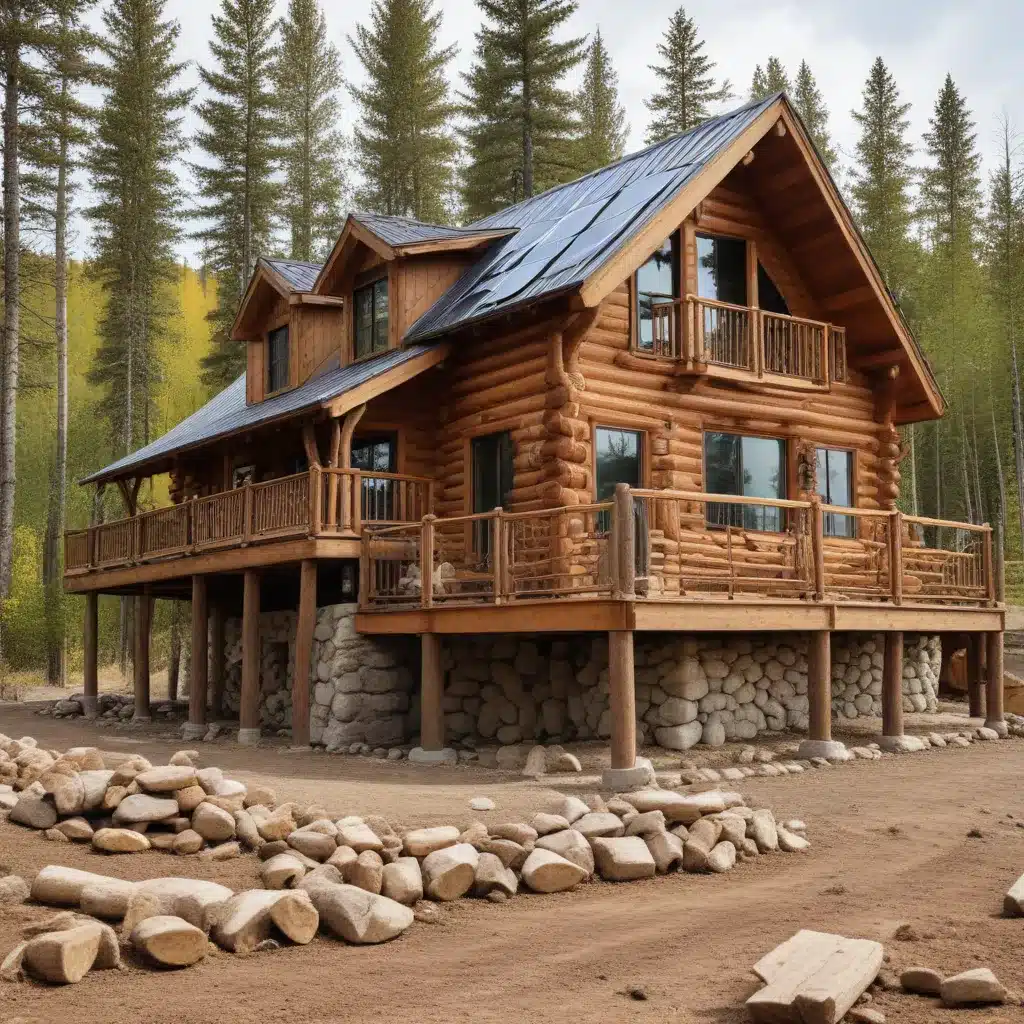
Embracing Sustainable Log Home Construction
In the pursuit of living in harmony with nature, off-grid log homes have become a captivating option for homeowners seeking a more self-sufficient and eco-friendly lifestyle. These abodes, crafted from the very elements that surround them, not only offer a rustic charm but also present innovative opportunities to harness renewable energy sources and minimize environmental impact.
As the demand for sustainable living grows, the construction of log homes has evolved to incorporate the latest advancements in renewable energy technologies. From solar panels to wind turbines, these homes are designed to operate independently from the traditional utility grid, providing homeowners with the freedom to live off the land while reducing their carbon footprint.
Harnessing the Power of the Sun
One of the most prominent renewable energy sources used in off-grid log homes is solar power. Advances in photovoltaic (PV) technology have made solar panels more efficient, affordable, and easier to integrate into the building’s design. Homeowners can opt for roof-mounted or ground-mounted solar arrays, strategically positioned to capture the maximum amount of sunlight throughout the day.
By incorporating solar panels, off-grid log homes can generate their own electricity, reducing their reliance on fossil fuels and providing a reliable source of power even during grid outages. Additionally, many log home builders offer customized solar energy systems, tailored to the specific energy demands and site conditions of each project.
Harnessing the Wind’s Power
While solar energy is a prevalent choice, some off-grid log home owners also harness the power of the wind to generate electricity. Small-scale wind turbines can be strategically placed on the property to capture the prevailing winds and supplement the home’s solar energy system.
Wind turbines work by converting the kinetic energy of the wind into electrical energy, which can then be used to power the home or stored in batteries for later use. The integration of wind turbines into the log home’s design can be a visually striking addition, further emphasizing the structure’s connection to the natural environment.
Optimizing Energy Efficiency
In addition to harnessing renewable energy sources, off-grid log homes are designed with energy efficiency in mind. The inherent thermal mass of the log walls, combined with strategic insulation and air-sealing techniques, helps to regulate the home’s temperature, reducing the need for extensive heating and cooling systems.
Many log home builders also incorporate energy-efficient windows, doors, and roofing materials to further enhance the building’s thermal performance. By minimizing energy consumption, these homes can rely more heavily on their renewable energy systems, reducing their environmental impact and operating costs.
Embracing Sustainable Materials
The construction of off-grid log homes often extends the focus on sustainability to the materials used. In addition to the logs themselves, which are a naturally renewable resource, builders may incorporate other eco-friendly materials such as:
- Reclaimed or Recycled Lumber: Repurposing wood from old buildings or demolition sites reduces waste and conserves natural resources.
- Sustainable Insulation: Options like cellulose, hemp, or sheep’s wool insulation provide excellent thermal performance with a lower environmental impact.
- Environmentally Friendly Finishes: Non-toxic paints, stains, and sealants minimize the introduction of harmful chemicals into the home.
By carefully selecting sustainable materials, off-grid log home builders can minimize the environmental footprint of the construction process and create a healthy, long-lasting living space.
Maintenance and Longevity
One of the key benefits of log homes is their inherent durability and longevity. With proper maintenance and care, these structures can withstand the elements for decades, providing a lasting investment for homeowners. Regular inspections, preventative maintenance, and timely repairs are essential to ensuring the log home’s structural integrity and energy efficiency.
Homeowners should be mindful of factors like moisture control, pest management, and the need for occasional re-chinking or re-staining to maintain the log walls’ protective barrier. By staying proactive with maintenance, off-grid log home owners can enjoy the beauty and comfort of their sustainable living space for years to come.
Embracing the Off-Grid Lifestyle
The decision to build an off-grid log home is often driven by a desire for self-sufficiency, a connection to nature, and a commitment to reducing one’s environmental impact. These homes offer homeowners the opportunity to live in harmony with the surrounding landscape, harnessing the power of renewable energy sources and minimizing their reliance on traditional utility providers.
While the initial investment in an off-grid log home may be higher than a conventional grid-tied home, the long-term benefits of energy independence, reduced operating costs, and a smaller carbon footprint can make it a worthwhile choice for those seeking a more sustainable lifestyle.
By embracing the principles of renewable energy, energy efficiency, and sustainable construction, off-grid log homes have become a compelling option for those who wish to live in harmony with nature and reduce their environmental impact. As the demand for eco-friendly living continues to grow, the construction of these self-sufficient sanctuaries is poised to become an increasingly prevalent trend in the years to come.
For more information on log home construction, custom log cabins, and timber frame homes in the United States, please visit Jørgensen Log Homes.


